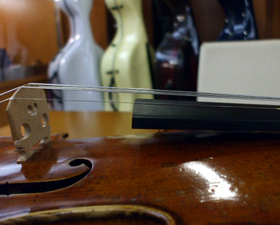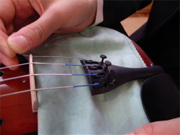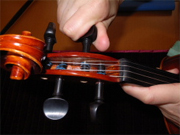Care and Maintenance of a Violin
Changing the strings
When should the strings be changed?
Strings on the instrument will eventually lose their shape and their tonal qualities. The strings should be changed regularly to maintain good tone quality. How much you play is also a factor, but all strings should be changed at least once a year.

Strings should be changed at least once a year.
Change your own strings
First, spread a mat on top of a table. Then, to protect the instrument, spread a cloth on the lower half of the body underneath the tailpiece. The bridge will come loose if the strings are all removed at once, so strings are changed one at a time. First, completely loosen the tuning peg and remove it from the peg box, then remove the string from the peg box hole. At the tailpiece, the small, round, metal part at the end of the string is simply wedged in the groove of the adjuster, so you can easily remove this as well.

Spread a cloth to avoid damaging the instrument.
Return the tuning peg to the peg box, put the end of the new string in the adjuster, and thread the other end of the string on the tuning peg and wind it up. Be sure to wind the string from the inside of the peg box to the outside, and tighten it enough to properly place it on the bridge. Once all the strings have been replaced, check and adjust the position of the bridge, and then tighten one string at a time to tune it.
This is not difficult work, so at least try doing it yourself first!
The E and A strings break easier than the others, so it is advisable to always keep an extra set in the case.

Turn the peg to wind the string.
Musical Instrument Guide : Violin Contents
Origins
Structure
How to Play
How the Instrument is Made
Choosing an Instrument
Care and Maintenance
Trivia
- The f-hole used to be a C-hole or S-hole
- Why the f-hole?
- Violinists must bow to the horse
- Steel strings or gut strings? That is the question
- Is the chinrest the unsung hero of the violin?
- Most violin varnishes are also medicines
- Violin masterpieces: Solos I
- Violin masterpieces: Solos II
- Violin masterpieces: Solos III
- Violin masterpieces: Concertos I
- Violin masterpieces: Concertos II
- Viola masterpieces: Chamber music
- Viola masterpieces: Concertos
- Cello masterpieces: Concertos I
- Cello masterpieces: Concertos II
- Cello masterpieces: Solos
- Contrabass masterpieces: Concertos
- Contrabass masterpieces: Chamber music
- Orchestral masterpieces featuring the contrabass
- What do you call the part on the bow that you hold?
